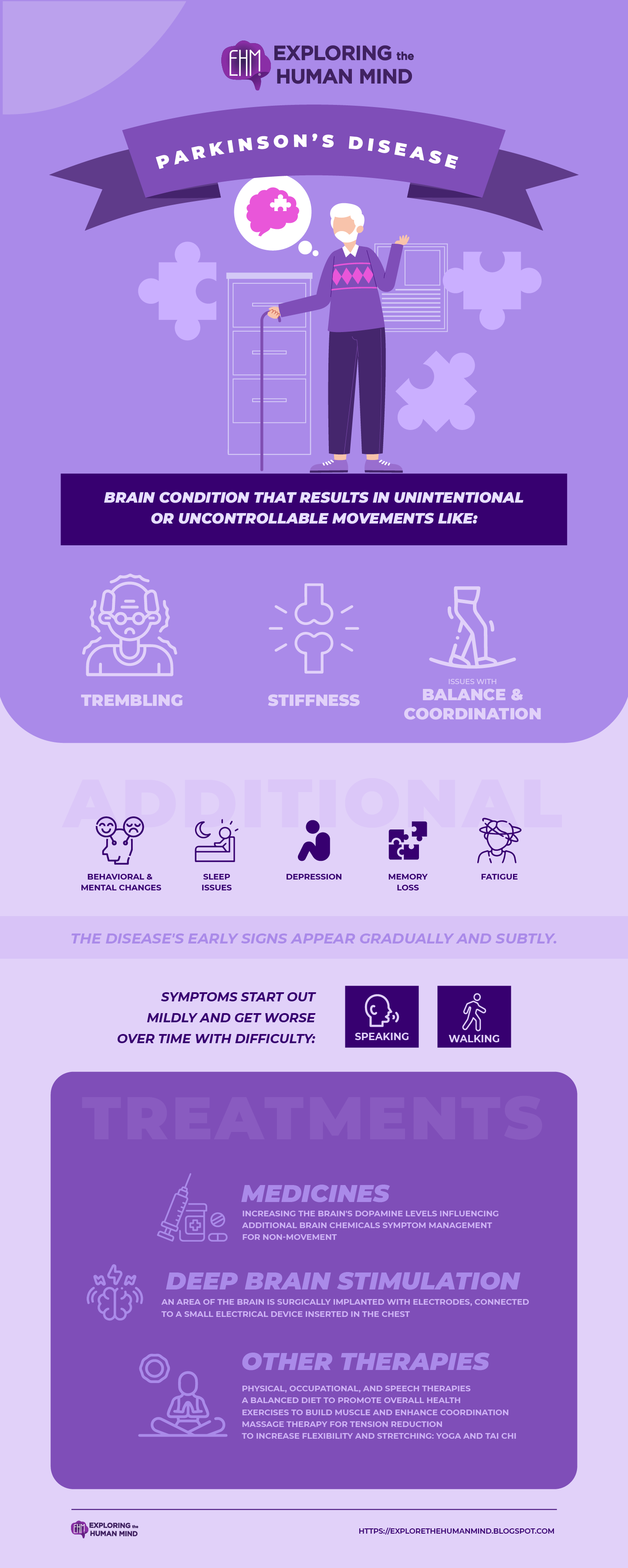Parkinson's disease
Typically, symptoms start out mildly and get worse over time. People might experience difficulty speaking and walking as the illness worsens. Additionally, they may experience behavioral and mental changes, sleep issues, depression, memory loss, and fatigue.
The substantia nigra pars compacta's dopaminergic neurons die as a result of Parkinson's disease. Although it exhibits a resting tremor, severe bradykinesia or akinesia is the most distressing symptom. Although reflexive, involuntary movements can sometimes be normal, patients with advanced illnesses have trouble initiating movements. It appears as though the loss of substantia nigra neurons has slowed the motor cortex's output and prevented voluntary motor commands from reaching the brain stem and spinal cord.
Causes
When nerve cells in the basal ganglia, a region of the brain that regulates movement, are damaged or killed, it results in the most noticeable signs and symptoms of Parkinson's disease. Dopamine is a crucial brain chemical that is normally produced by these nerve cells, or neurons.
The disease-related movement issues are brought on by the neurons' diminished or dying ability to produce dopamine. What kills the neurons is still a mystery to scientists.
Symptoms
Parkinson’s has four main symptoms:
- tremor in hands, arms, legs, jaw, or head
- muscle stiffness, where muscle remains contracted for a long time
- slowness of movement
- impaired balance and coordination, sometimes leading to falls
Other symptoms may include:
- depression or other emotional changes
- difficulty swallowing, chewing, and speaking
- urinary problems or constipation
- skin problems
Parkinson's disease symptoms and progression rates vary from person to person. The disease's early signs appear gradually and subtly.
Parkinson's disease patients frequently develop a parkinsonian gait, which includes a propensity to lean forward, take short, quick steps, and lessen arm swinging. Additionally, they might struggle to start or maintain movement.
Treatments for Parkinson’s disease
Medicines
In order to treat the signs of Parkinson's disease, medications can:
- increasing the brain's dopamine levels
- influencing additional brain chemicals, such as neurotransmitters, which transport information between brain cells
- symptom management for non-movement
Levodopa is the main treatment for Parkinson's disease. Levodopa is converted by nerve cells into dopamine to replenish the depleting levels in the brain.
Deep brain stimulation
The doctor might advise deep brain stimulation for Parkinson's disease patients who do not respond well to medication. An area of the brain is surgically implanted with electrodes, and these electrodes are connected to a small electrical device inserted in the chest.
Other therapies
Other therapies that may help manage Parkinson’s symptoms include:
- physical, occupational, and speech therapies may help with gait and voice issues, tremors and rigidity, and a decline in mental abilities, among other symptoms of Parkinson's disease.
- a balanced diet to promote overall health
- exercises to build muscle and enhance coordination, flexibility, and balance
- massage therapy for tension reduction
- to increase flexibility and stretching, try yoga and tai chi.
Even though Parkinson's disease usually develops gradually, a person's daily activities eventually might be impacted. Working, maintaining a home, and taking part in social activities with friends can all become difficult. Although going through these changes can be challenging, support groups can help people adjust. For people with Parkinson's disease, their families, and carers, these groups can offer information, suggestions, and connections to resources.

vectors by Freepick; graphic design by Vadot
Reference:
Disorders of the Motor System (Section 3, Chapter 6) Neuroscience Online: An Electronic Textbook for the Neurosciences | Department of Neurobiology and Anatomy - The University of Texas Medical School at Houston. (2020). Tmc.edu. https://nba.uth.tmc.edu/neuroscience/m/s3/chapter06.html Parkinson’s Disease: Causes, Symptoms, and Treatments. National Institute on Aging. (2022). https://www.nia.nih.gov/health/parkinsons-disease#:~:text=Parkinson%27s%20disease%20is%20a%20brain,have%20difficulty%20walking%20and%20talking.






Comments
Post a Comment